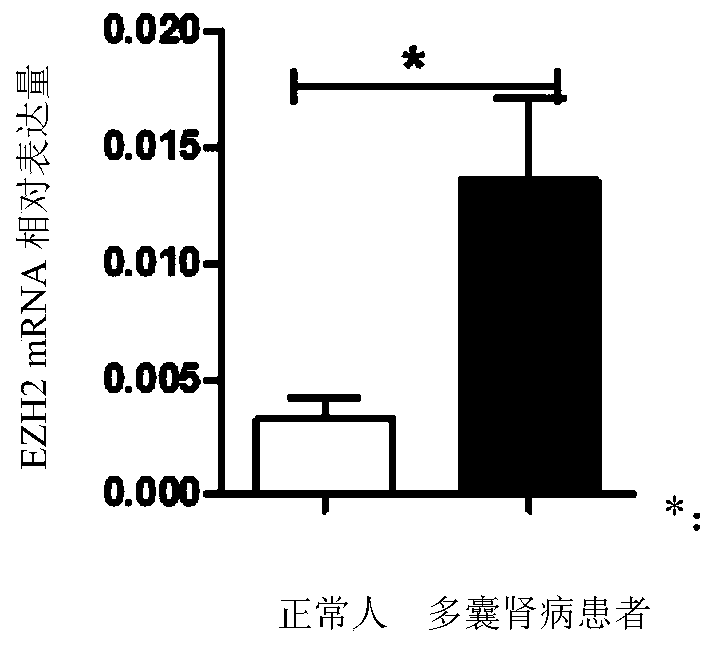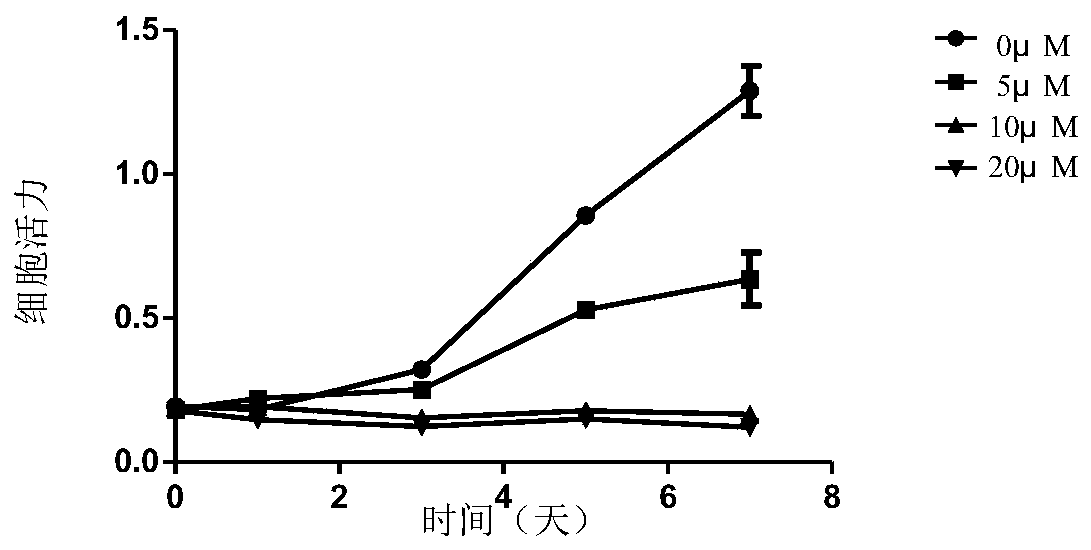Application of EZH2 (enhancer of zeste homolog 2) in preparation of drugs to prevent or treat polycystic kidney disease
A polycystic kidney disease, EZH2 technology, applied in the field of medicine, can solve the problems of EZH2 and its inhibitor application that have not been reported
- Summary
- Abstract
- Description
- Claims
- Application Information
AI Technical Summary
Problems solved by technology
Method used
Image
Examples
Embodiment 1
[0052] Example 1: EZH2 mRNA and protein are highly expressed in kidney tissue of patients with polycystic kidney disease
[0053] Collect patient's kidney tissue, the people's polycystic kidney tissue used in the experiment of the present invention comes from polycystic kidney surgery patient; Normal control tissue comes from the paracancerous tissue (distance from tumor side > 3cm) of kidney cancer surgery patient. In the present invention, the 4 cases of ADPKD patients all have a family history of polycystic kidney disease, the typical manifestations of multiple cysts in both kidneys can be seen in the imaging examination, the chronic kidney disease CKD 4-5 stage, and the kidney tissues of 4 cases of normal control all come from the same period of unilateral Kidney cancer patients undergoing nephrectomy. RNA was extracted from the renal tissues of patients with polycystic kidney disease and the normal control group for PCR experiments, and it was found that EZH2 mRNA was hig...
Embodiment 2
[0054] Example 2: Effect of GSK126 on proliferation of human polycystic kidney cyst lining epithelial cell line WT9-12
[0055] Human polycystic kidney cyst lining epithelial cell line WT9-12 was cultured in DMEM / F12 medium with 10% fetal bovine serum, added with double antibodies, and passaged by trypsinization. After about 70% of cell confluence, trypsinize, make cell suspension, count cells under microscope, and then inoculate in 96-well plate, 6×10 per well 3 cells. After synchronization, GSK126 was given, and the concentration gradient of GSK126 was 5 μM, 10 μM, and 20 μM. The changes of cell proliferation after administration 1, 3, 5 and 7 days were observed by MTT method. Aspirate the culture medium at each time point, add 10 μl of medium to each well and add 10 μl of MTT (5mg / ml aqueous solution), incubate at 37°C for 3 hours, suck out the culture medium, add 100 μl of DMSO to each well, and shake at room temperature for 15 minutes. The wavelength measures the OD va...
Embodiment 3
[0058] Example 3: Effect of GSK126 on apoptosis and cell cycle of human polycystic kidney cyst lining epithelial cells WT9-12
[0059] WT9-12 cells were treated with 2×10 5 cells / well were seeded in a 6-well plate, and when 60-70% confluence was reached, the cells were treated with 5 μM, 10 μM, and 20 μM of GSK126 for 48 hours. Collect cells and supernatant, trypsinize and centrifuge, wash cells with cold 1×PBS and centrifuge at 1000rpm / min for 10 minutes. Discard the supernatant, add 1×binding buffer, adjust the cell concentration to 1×10 6 cells / ml. Add 5 μl Annexin V and 1 μl PI (100 μg / ml) working solution to every 100 μl cell suspension, incubate at room temperature for 15 minutes in the dark, then add 400 μl 1× binding buffer, mix well and place on ice, then use flow cytometry as soon as possible Apoptosis was measured by cytometer, and the results indicated that GSK126 could significantly induce apoptosis of WT9-12 cells, see Figure 4 .
[0060] WT9-12 cells were ...
PUM
 Login to View More
Login to View More Abstract
Description
Claims
Application Information
 Login to View More
Login to View More - R&D Engineer
- R&D Manager
- IP Professional
- Industry Leading Data Capabilities
- Powerful AI technology
- Patent DNA Extraction
Browse by: Latest US Patents, China's latest patents, Technical Efficacy Thesaurus, Application Domain, Technology Topic, Popular Technical Reports.
© 2024 PatSnap. All rights reserved.Legal|Privacy policy|Modern Slavery Act Transparency Statement|Sitemap|About US| Contact US: help@patsnap.com










